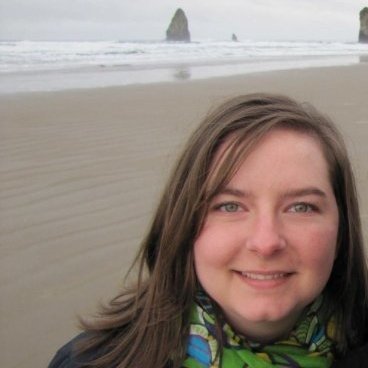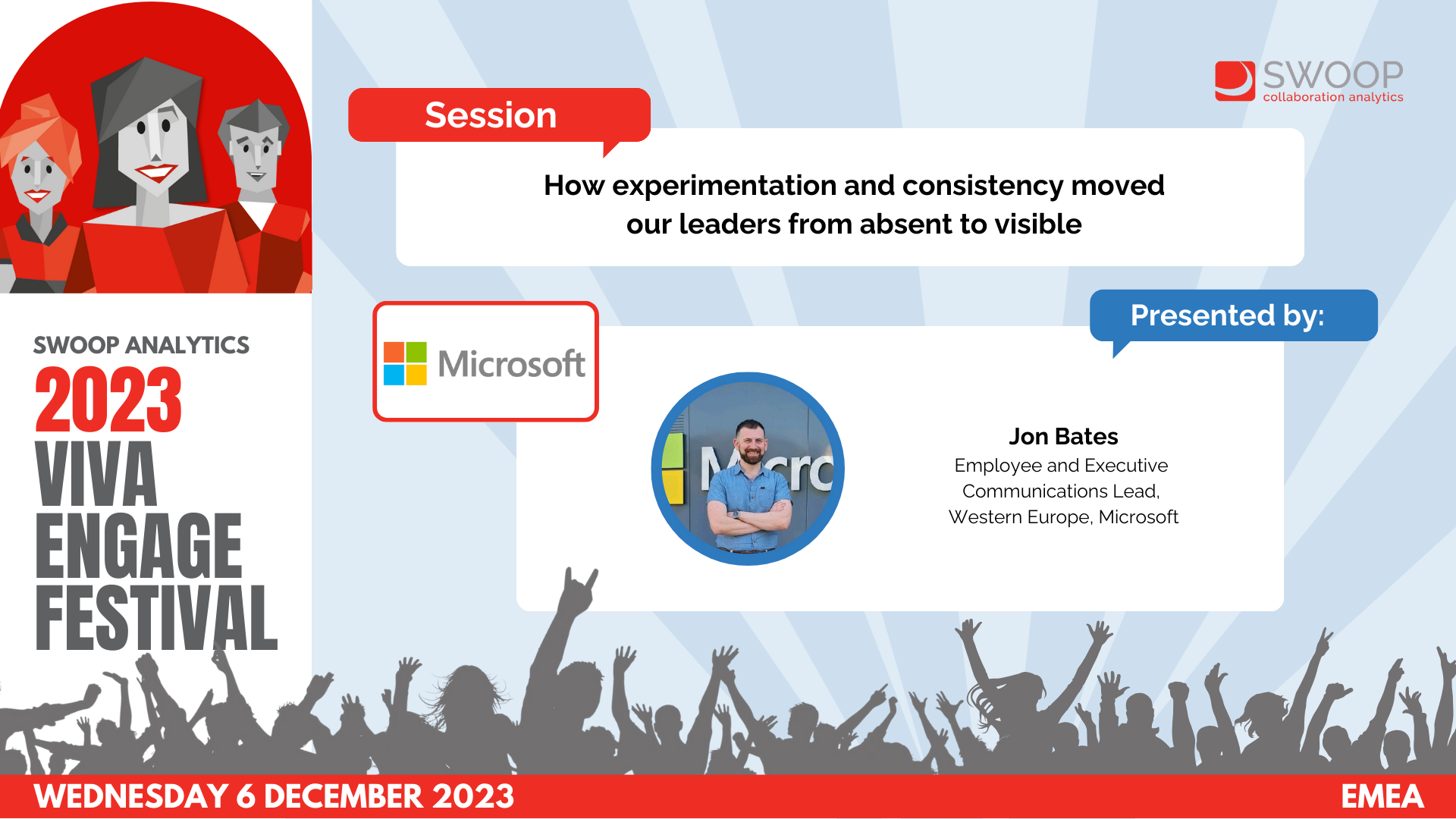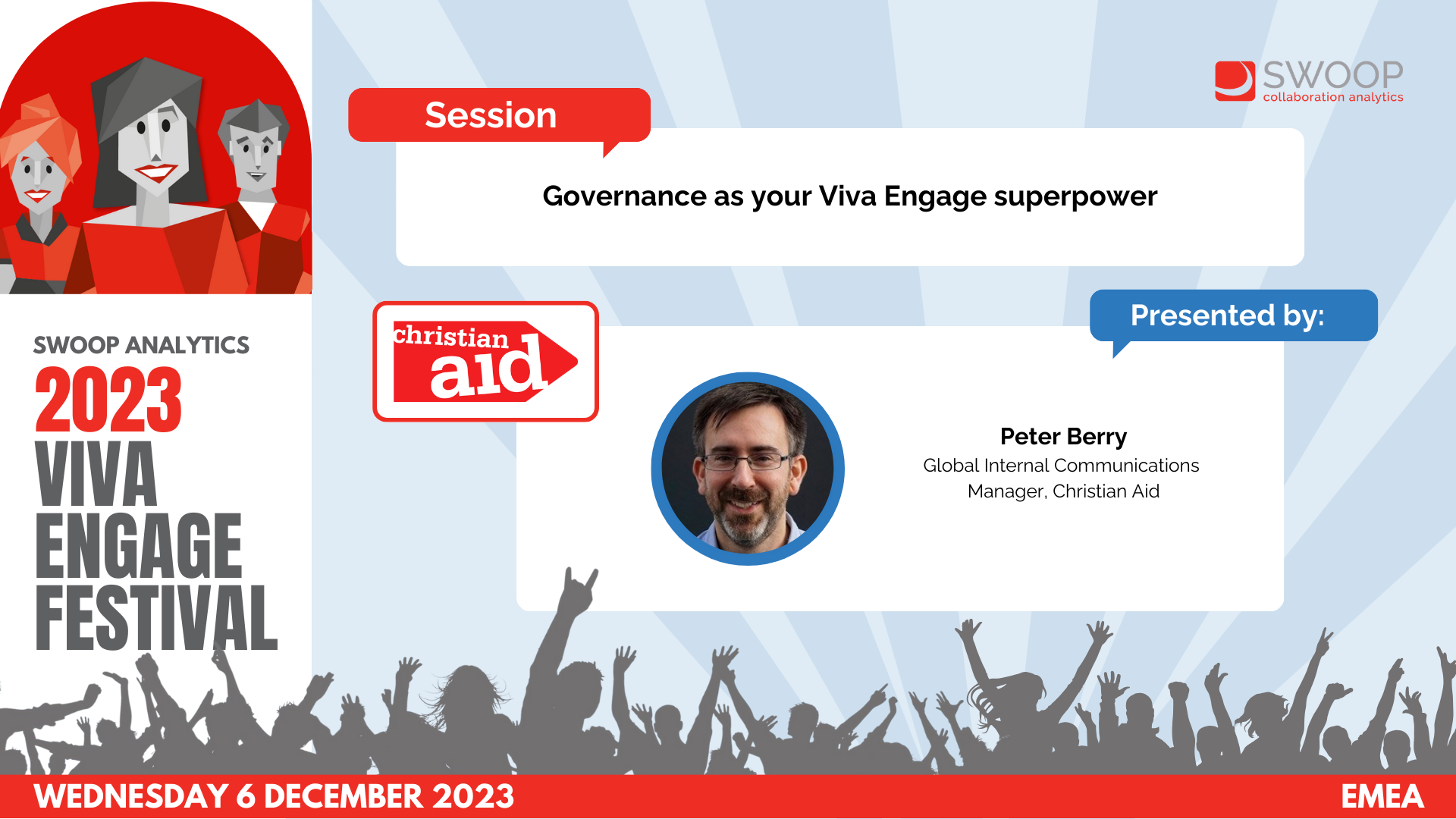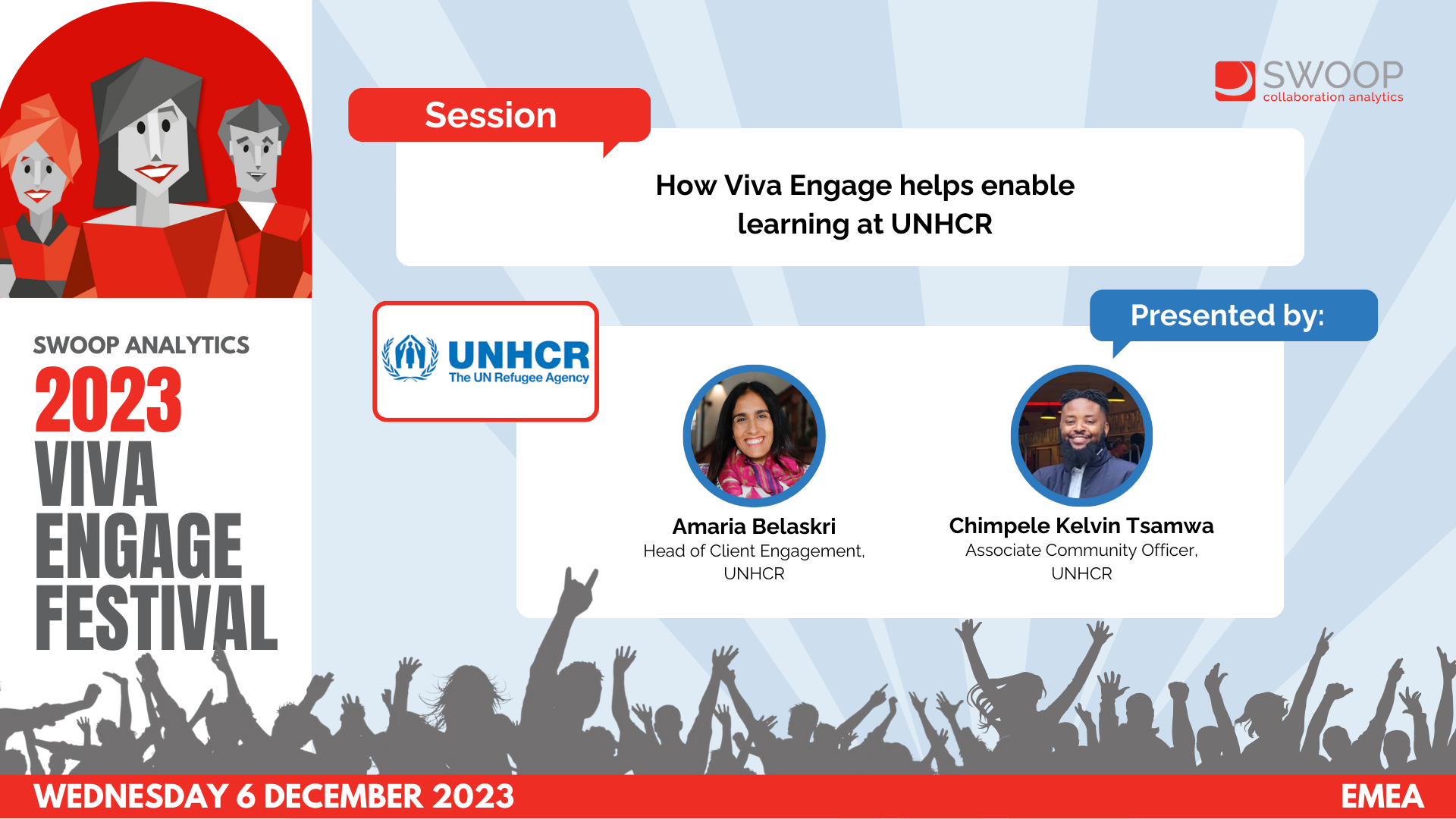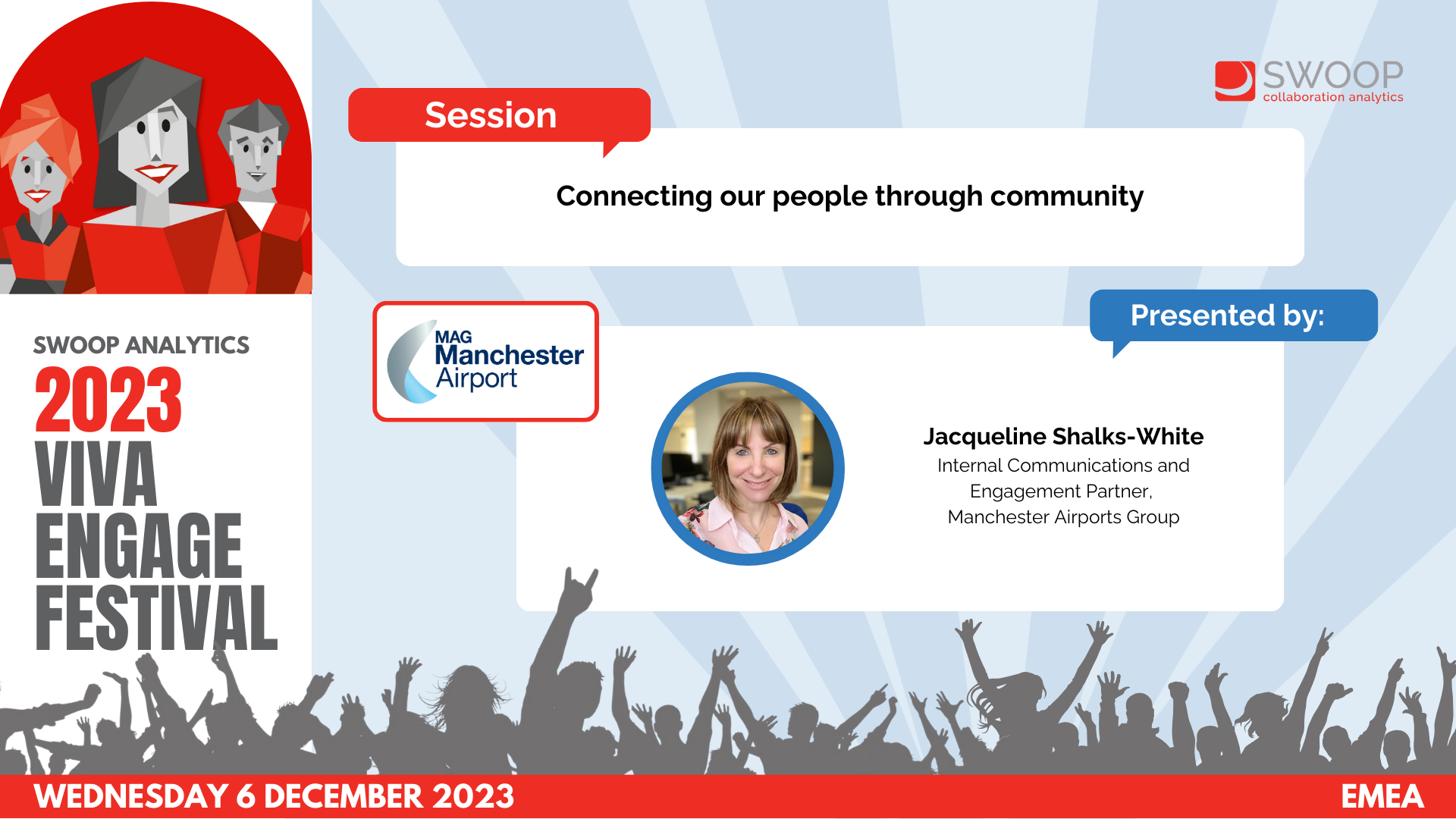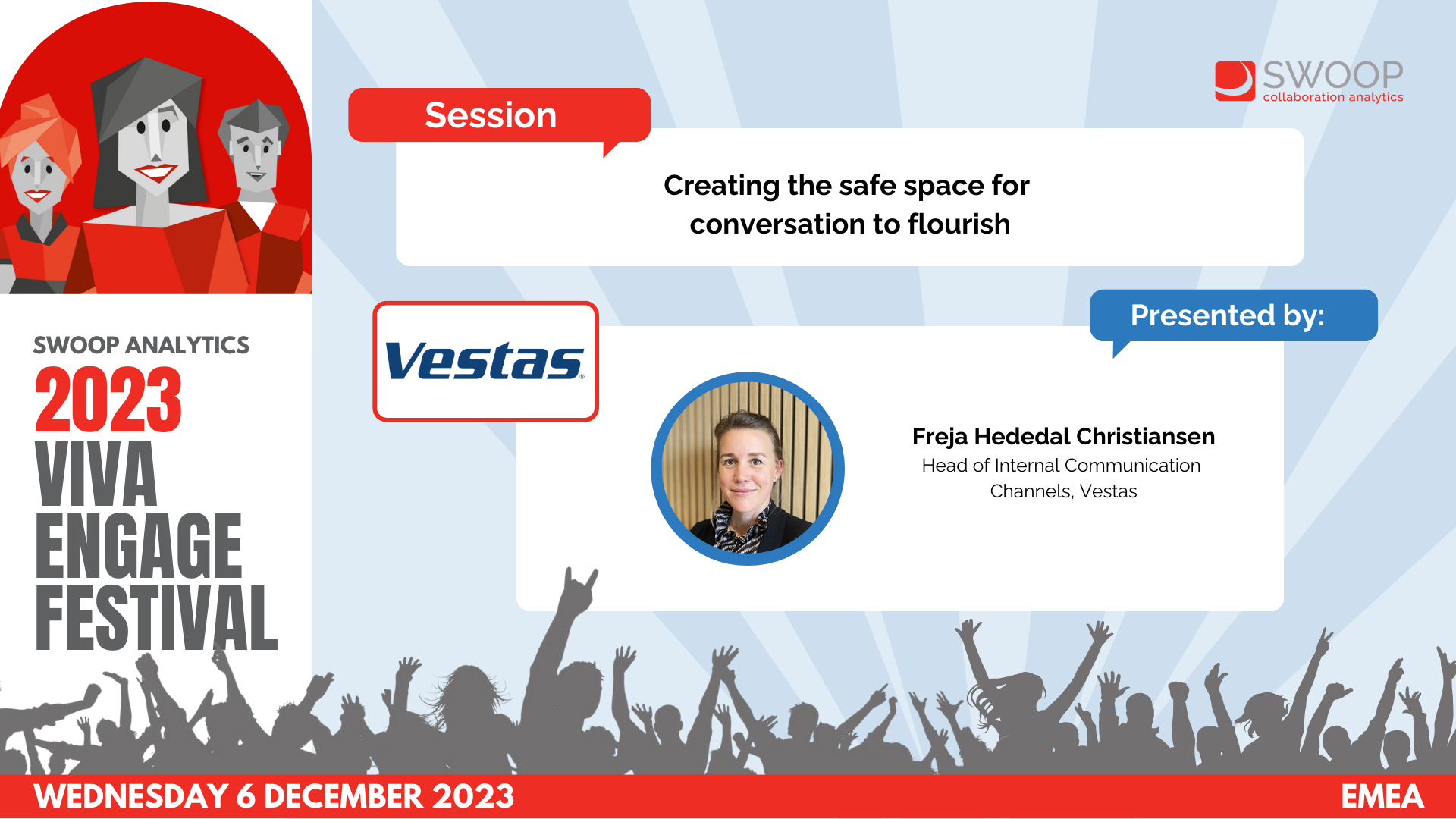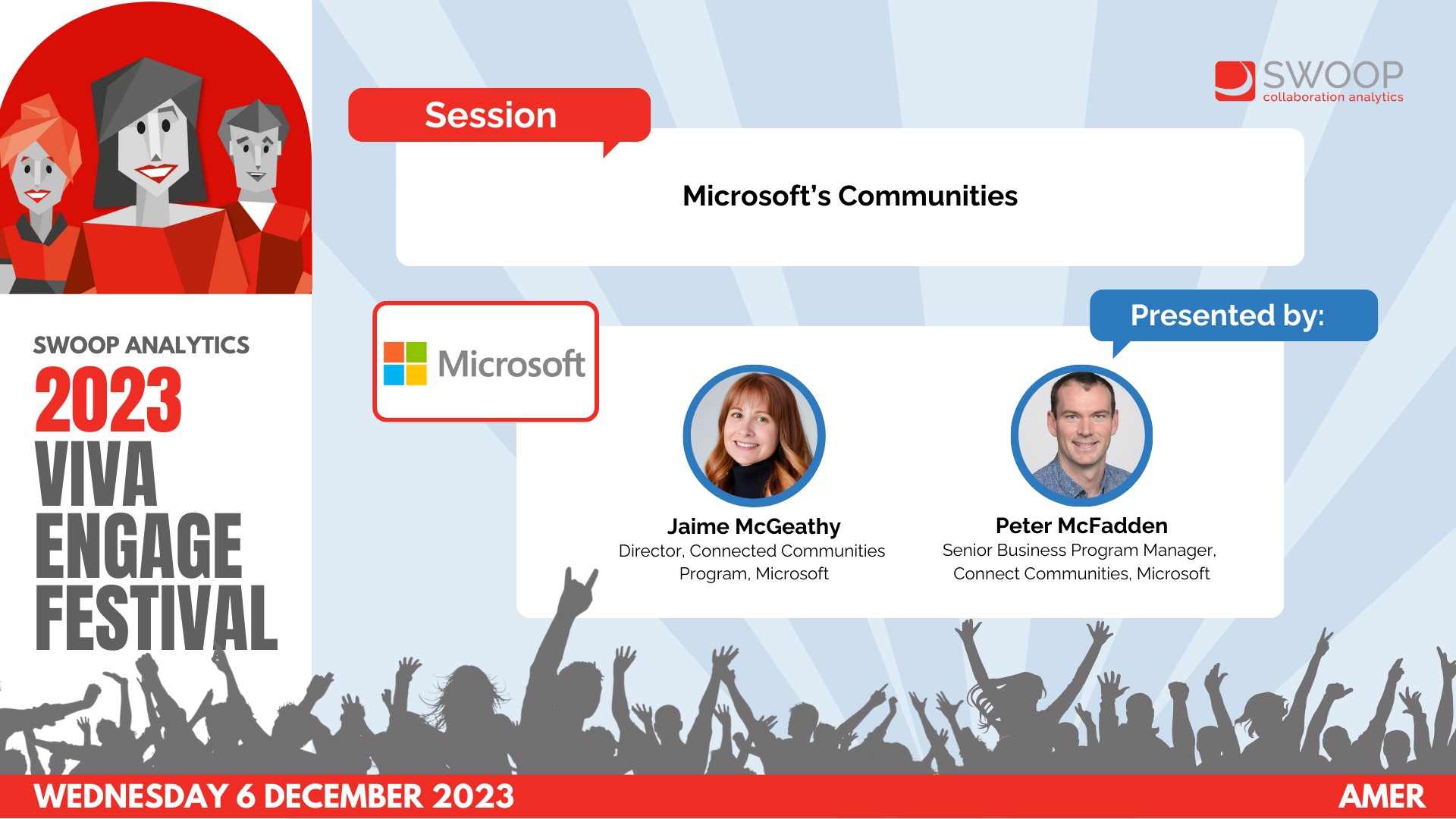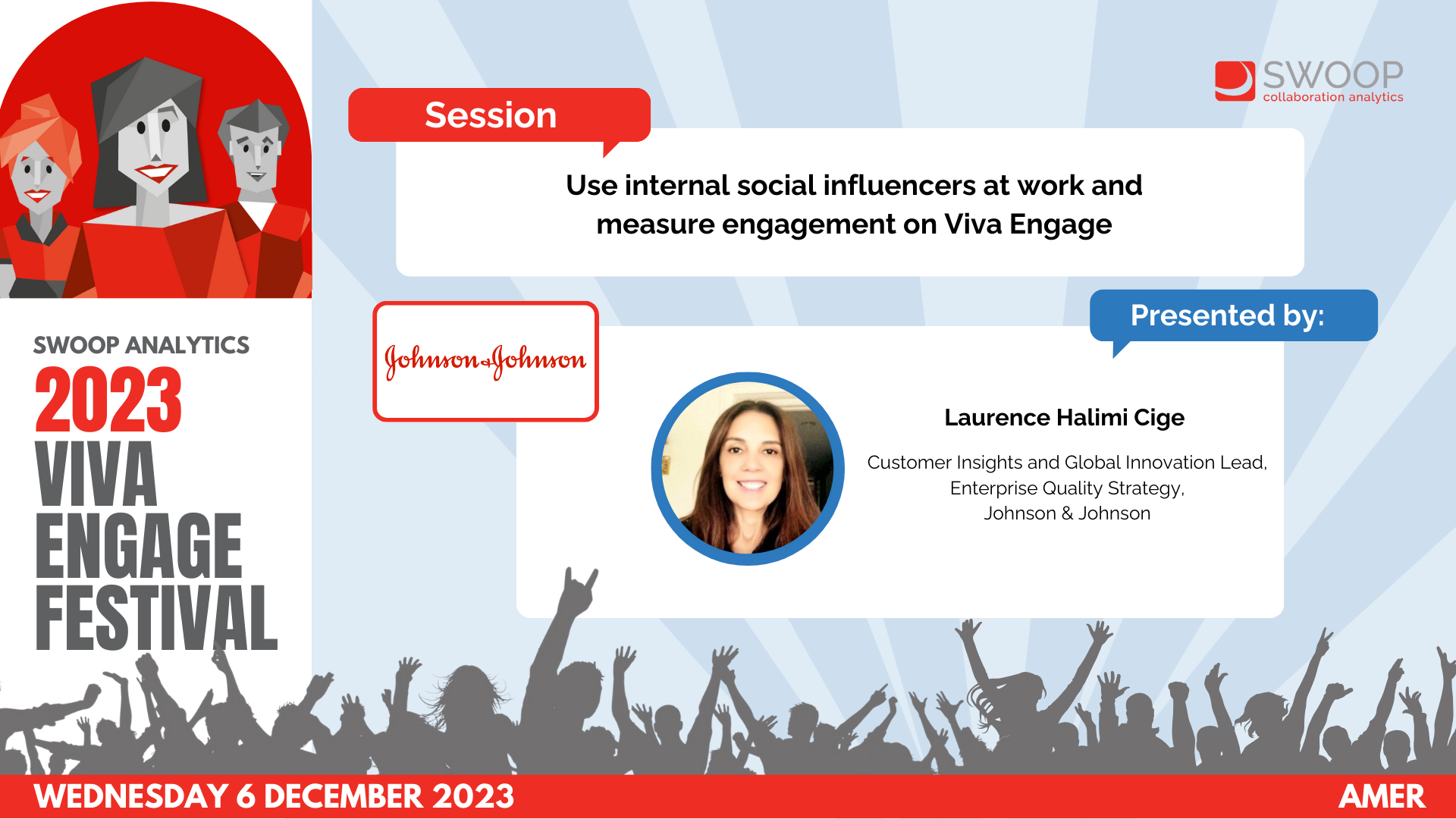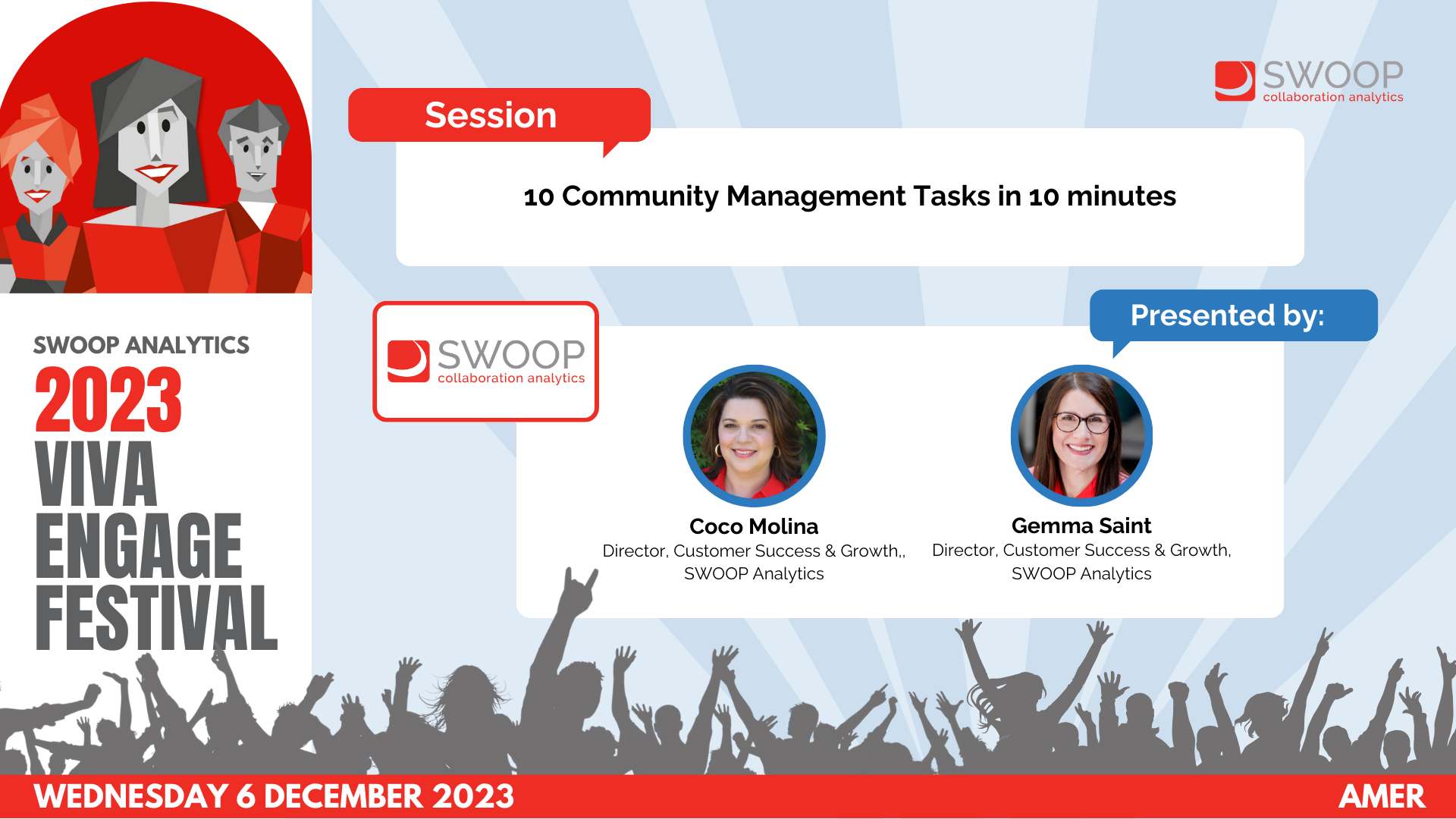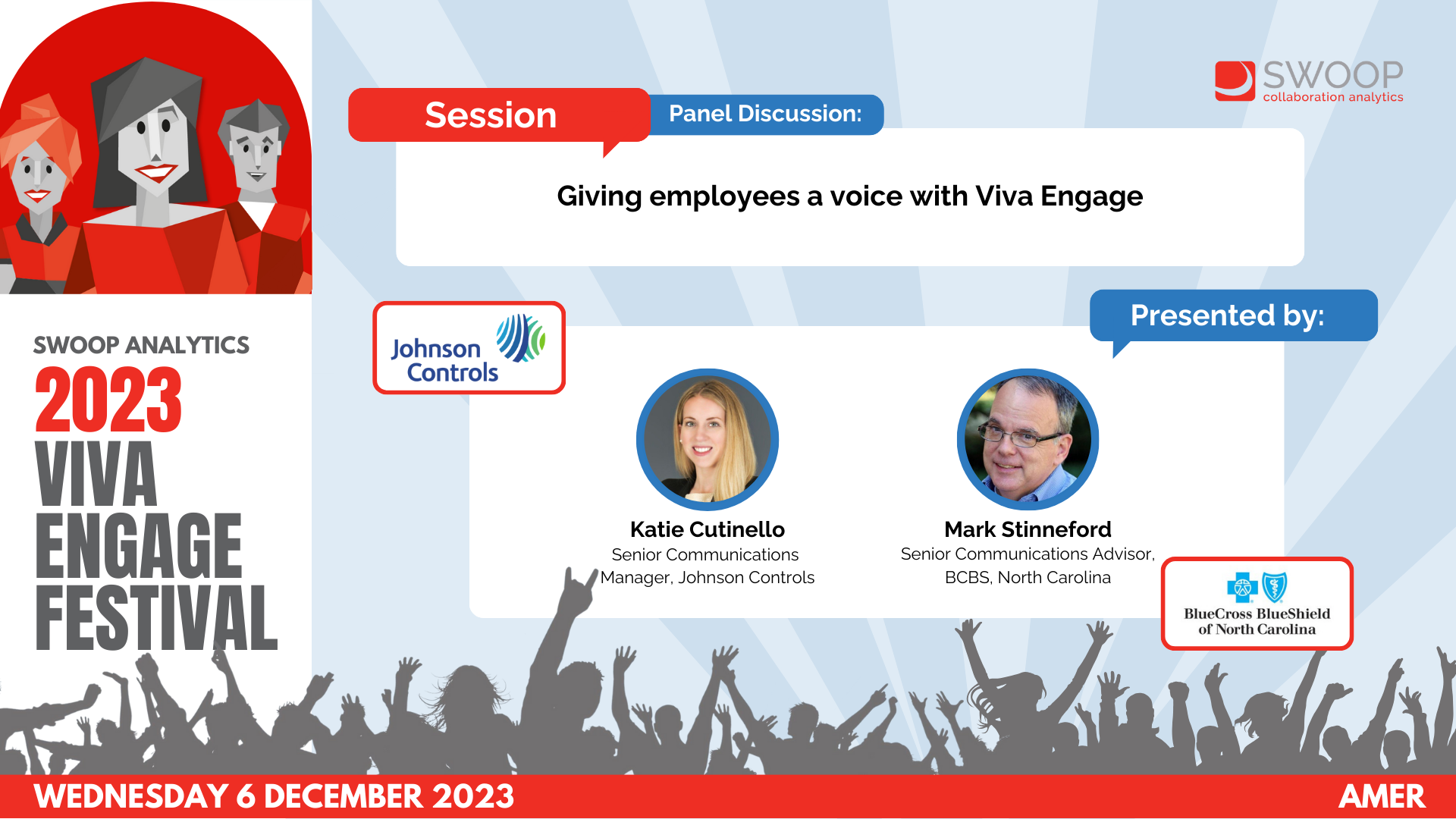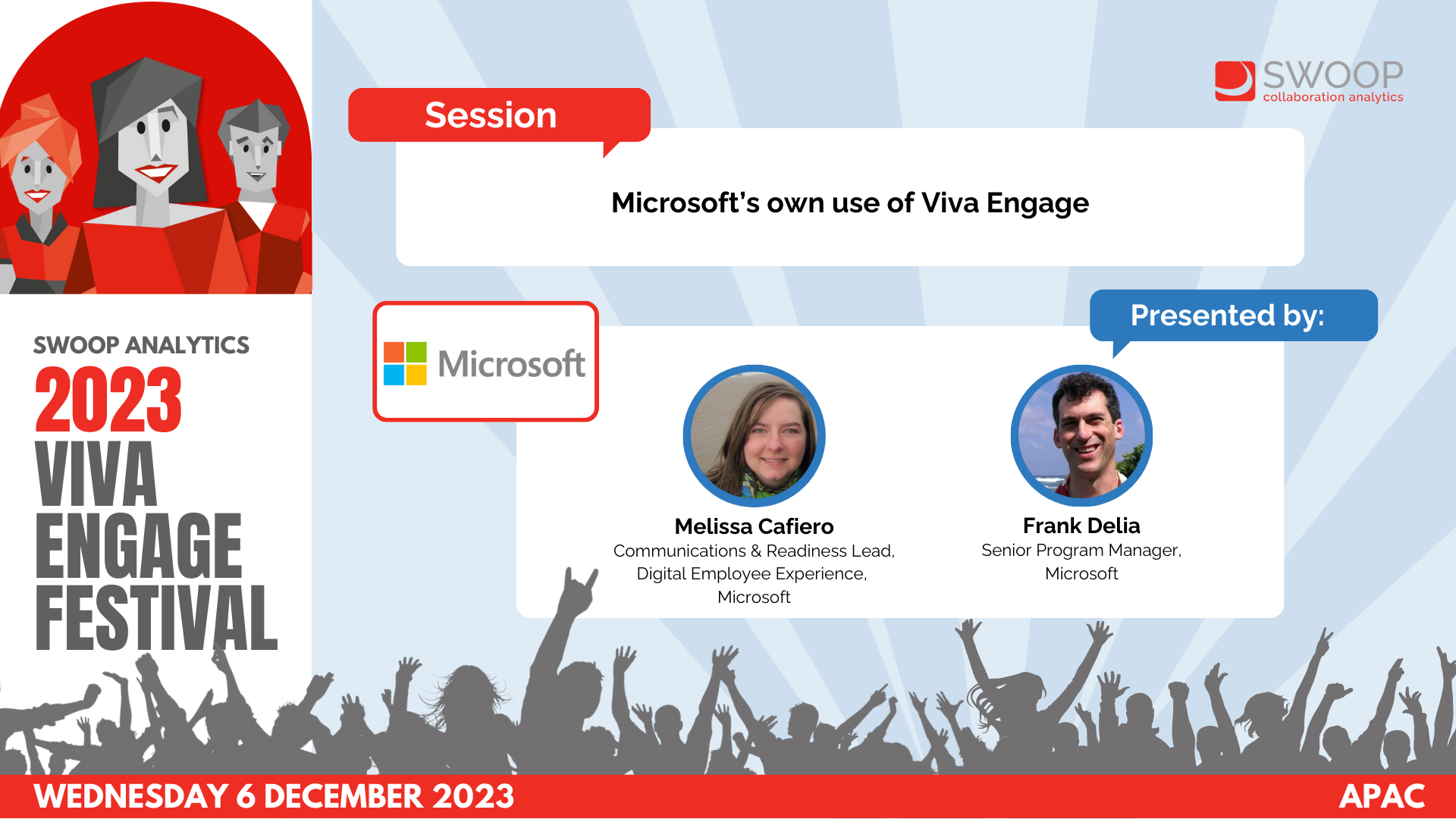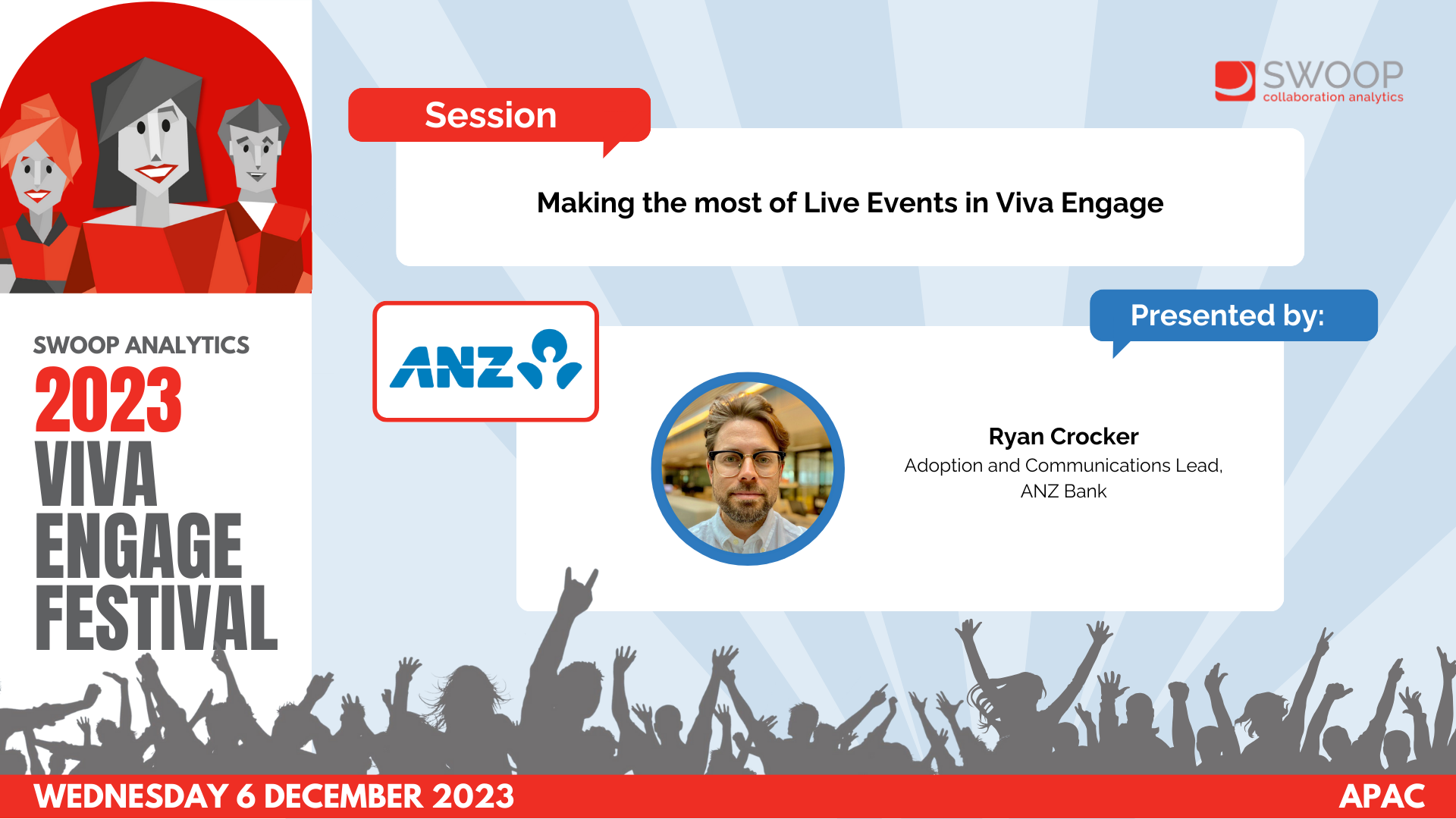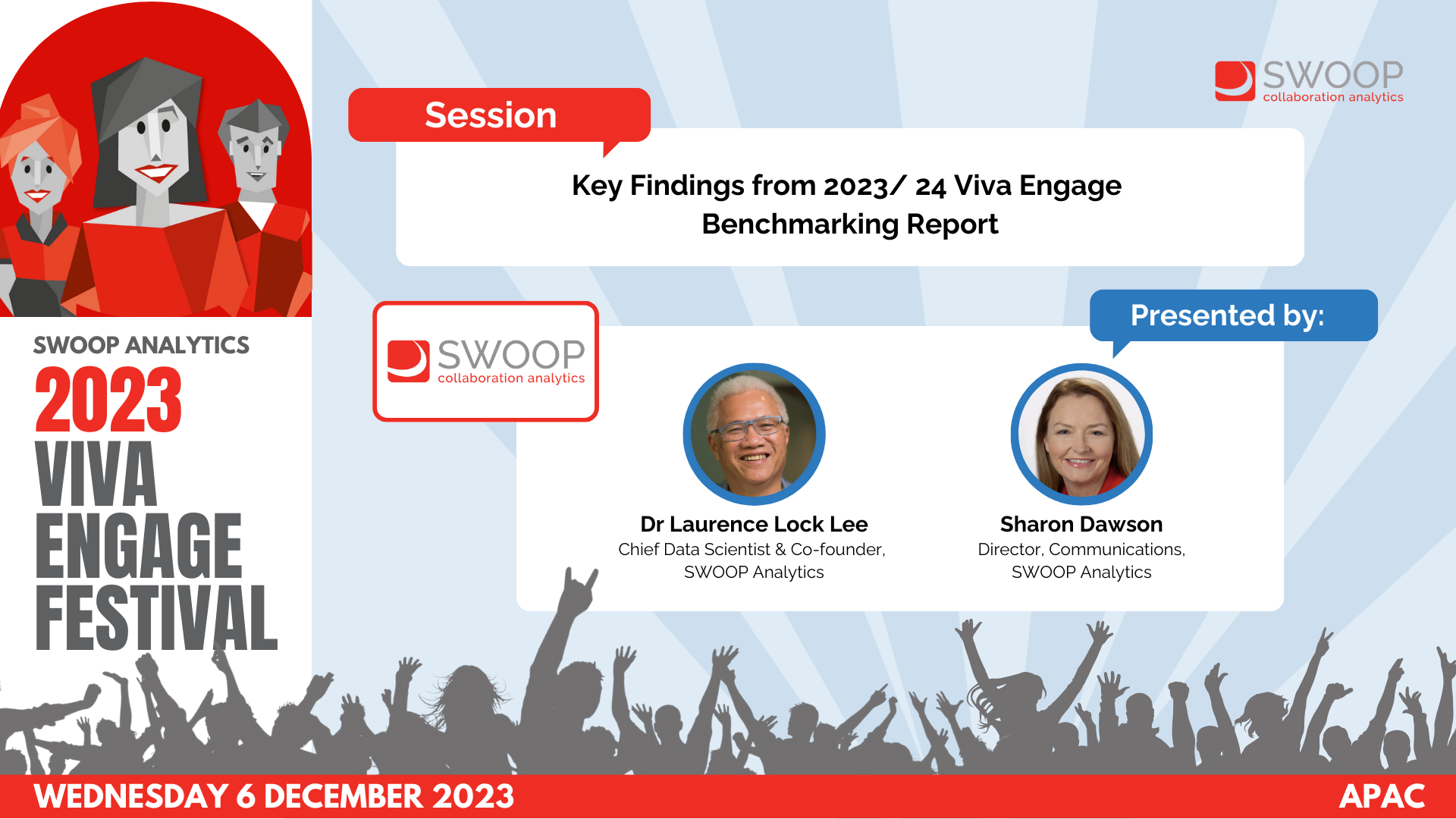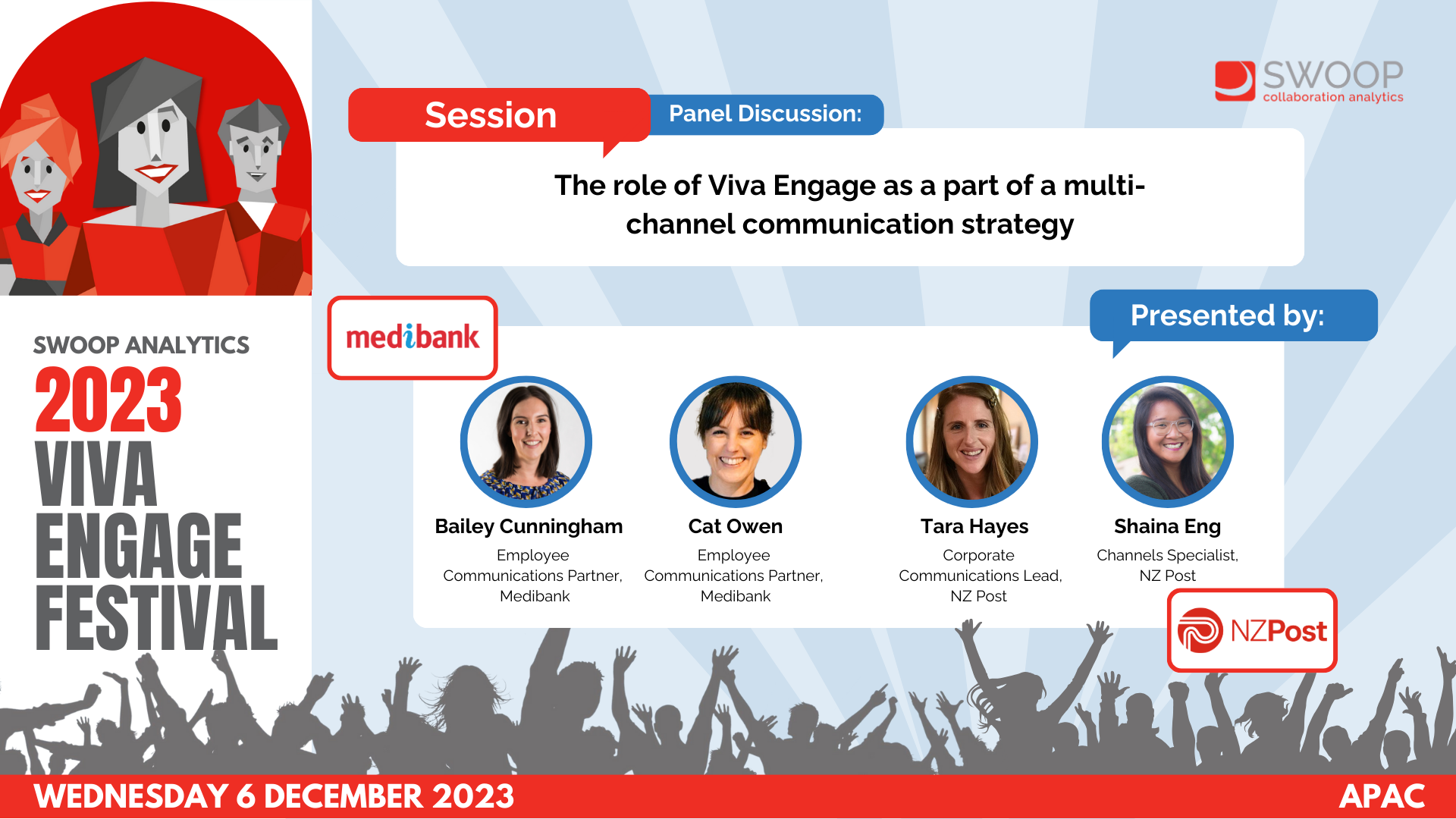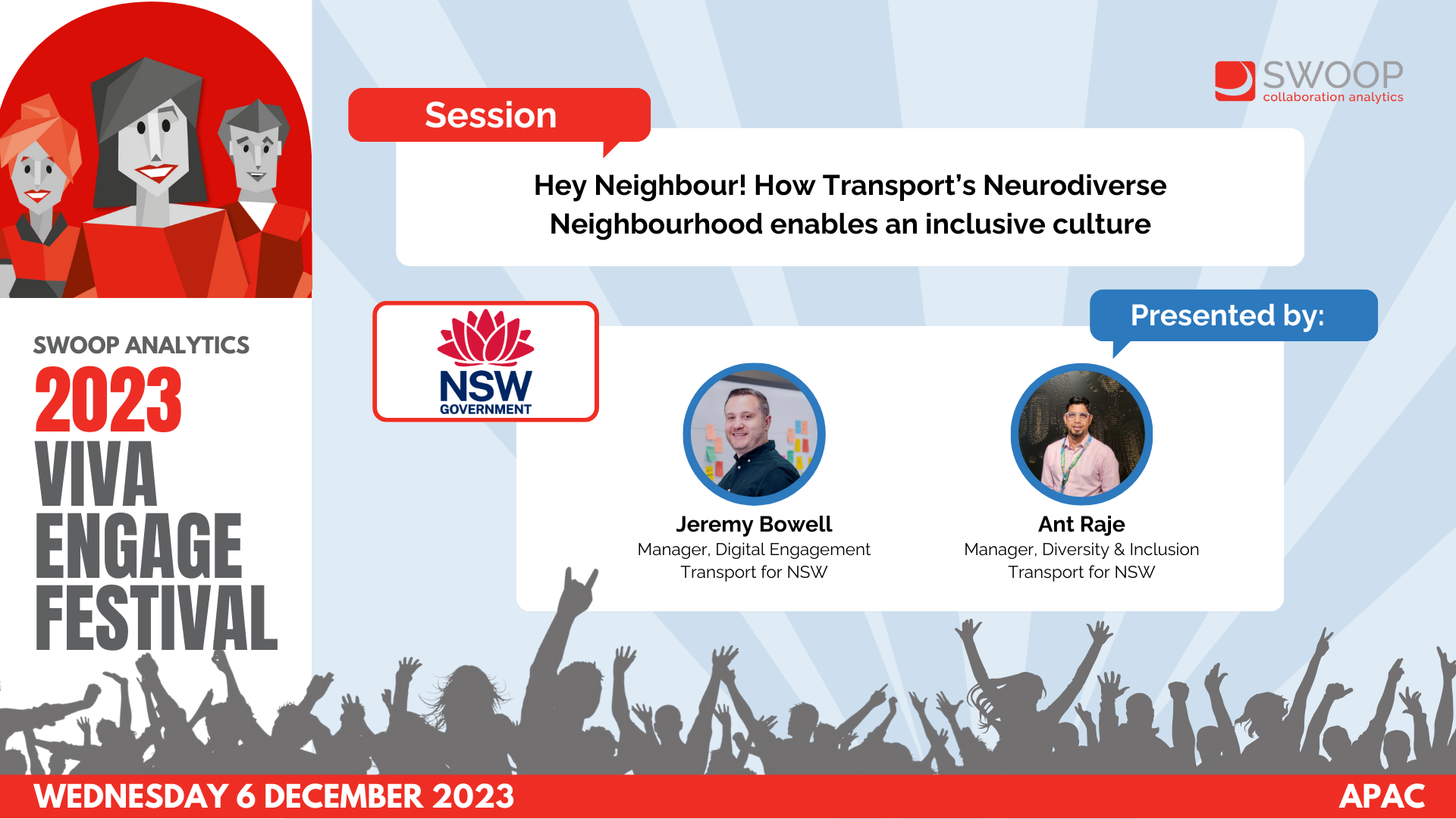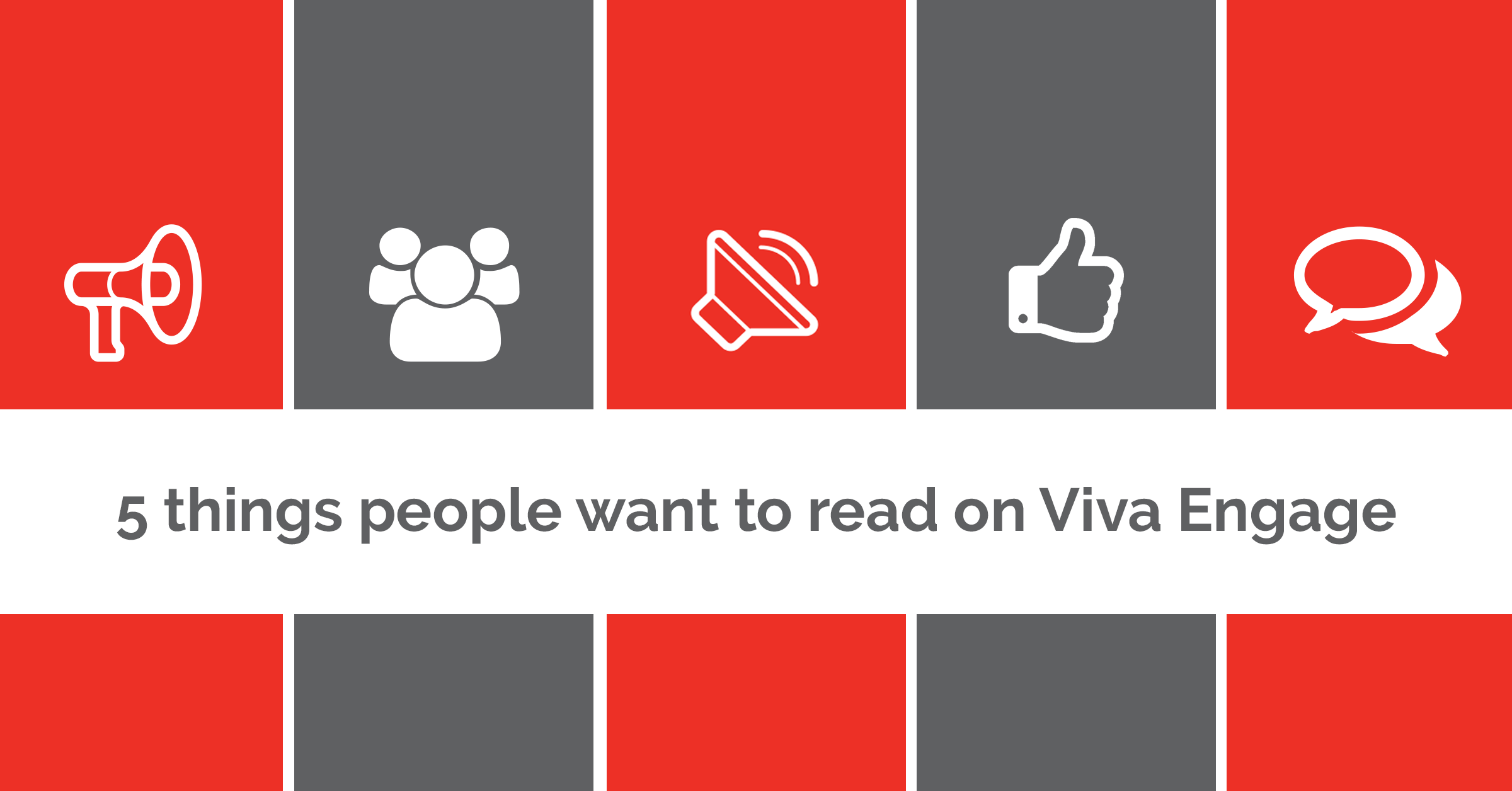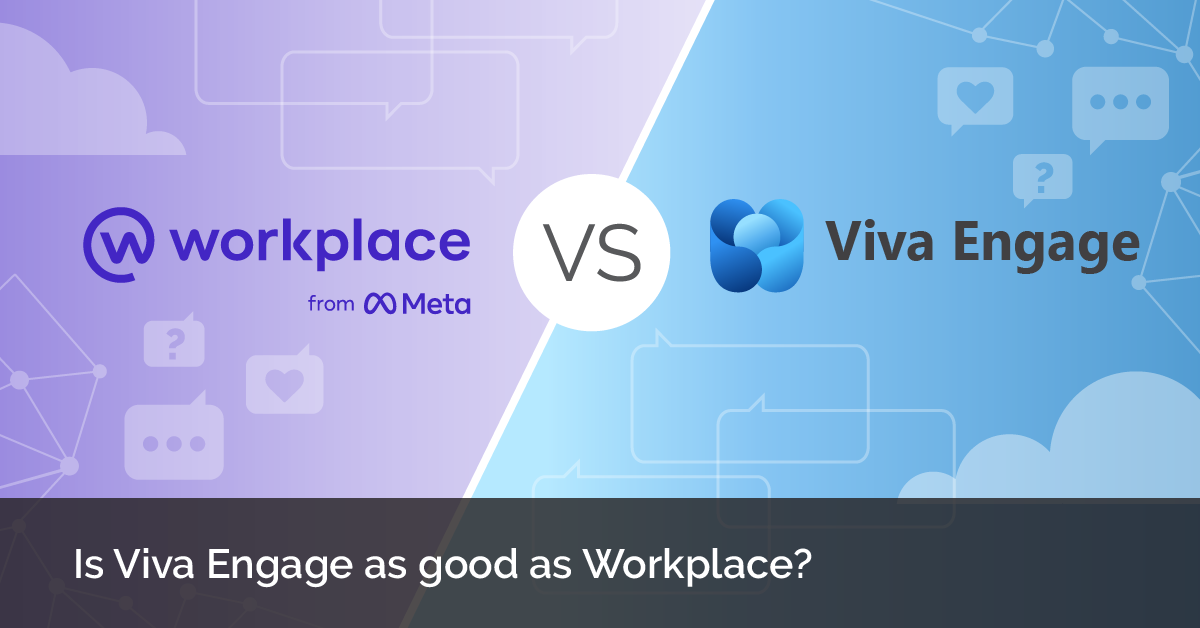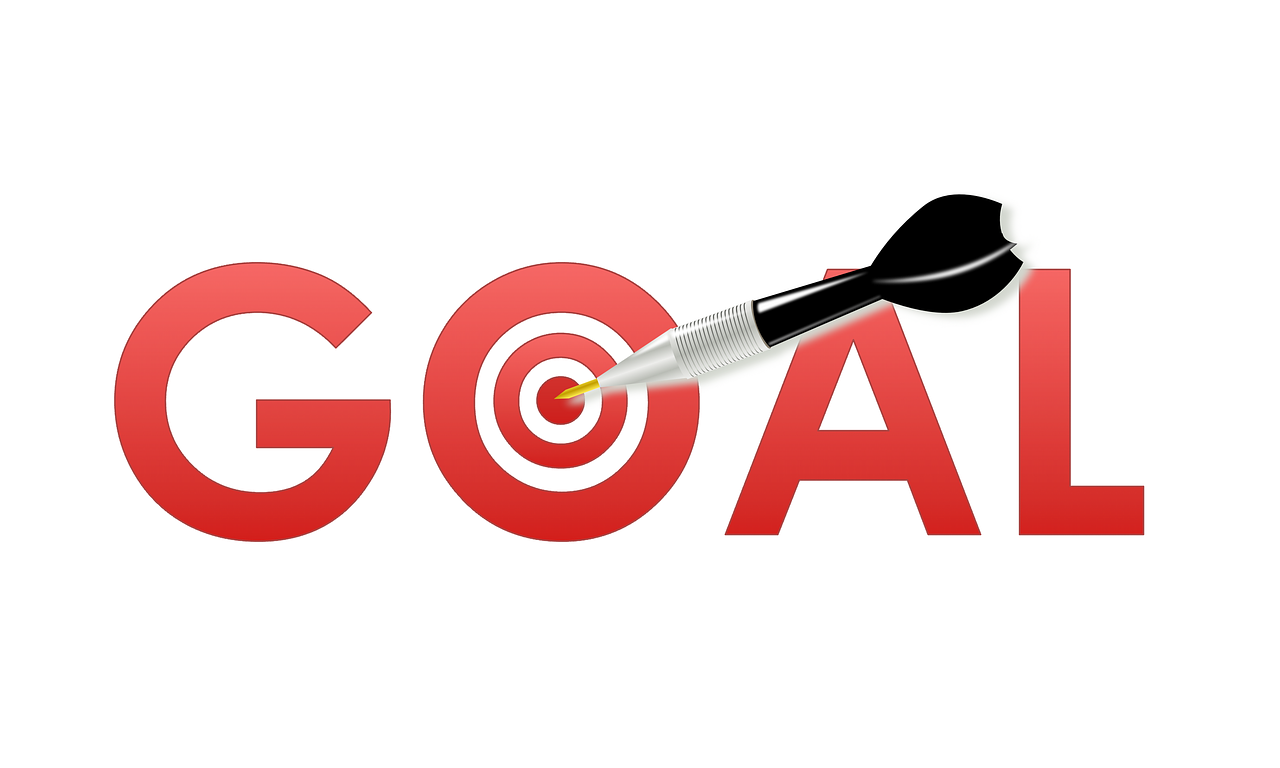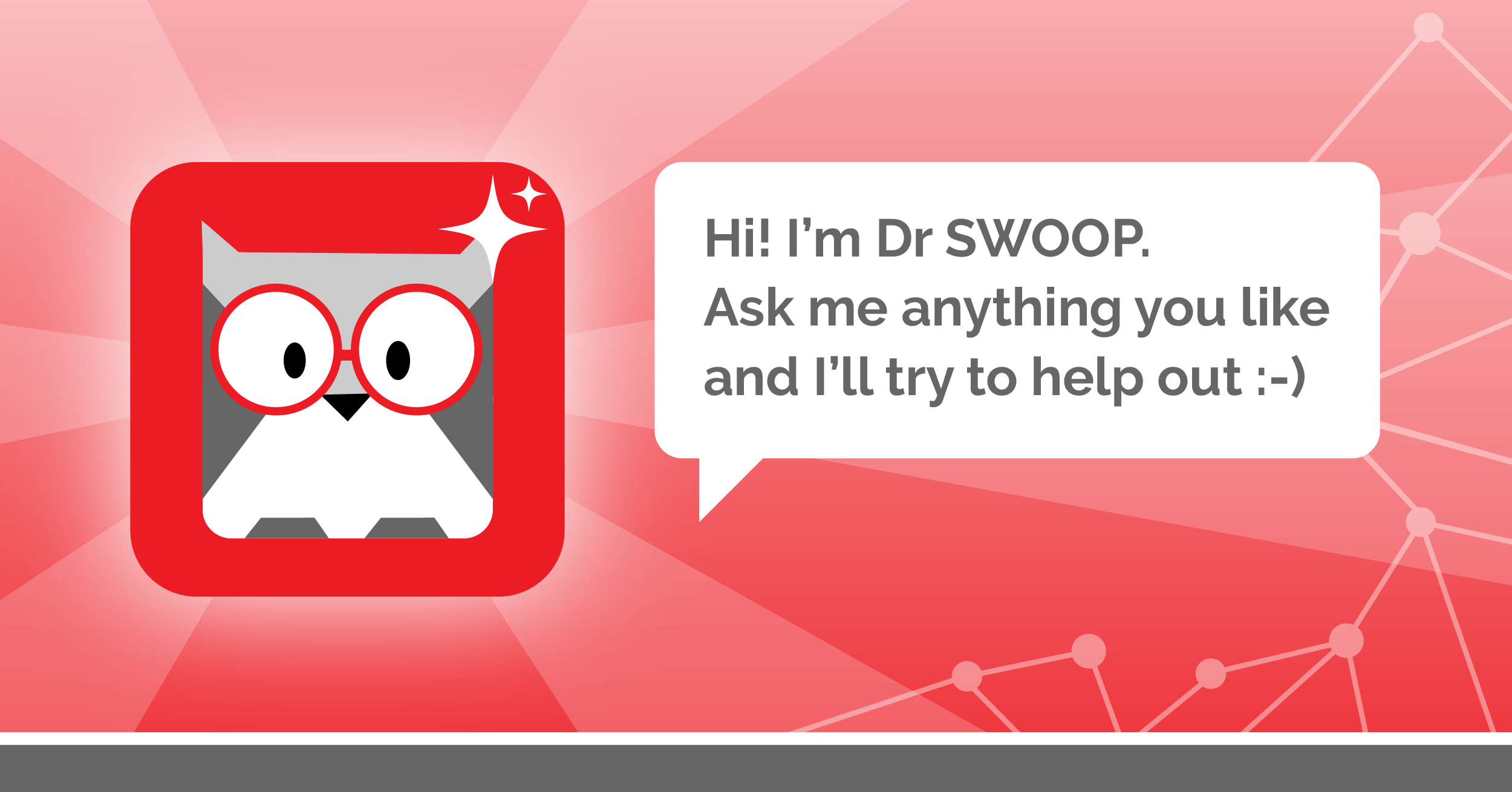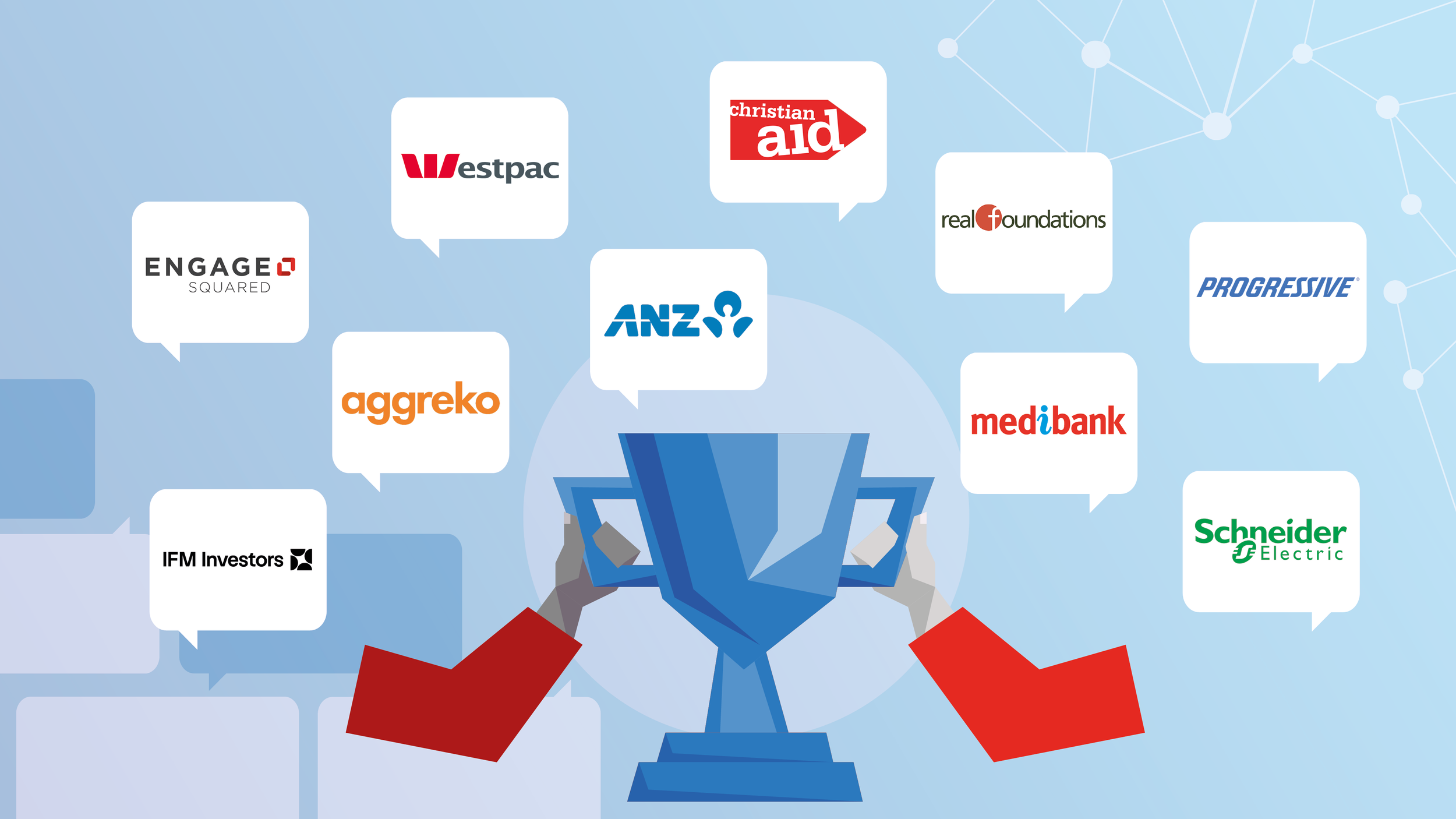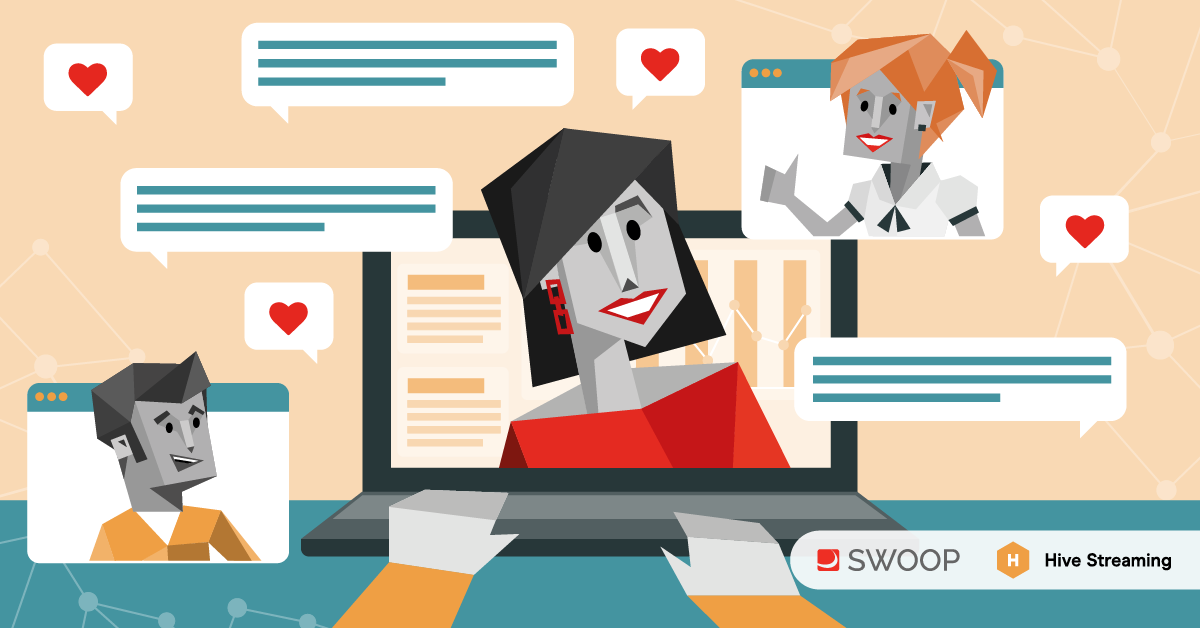Microsoft: Microsoft’s own use of Viva Engage
APAC | Viva Engage Festival 2023
Join us for an exclusive look into Microsoft's journey with Viva Engage. Gain valuable insights from our experiences, including behind-the-scenes details, adoption strategies, change management techniques, and communication practices that have driven employee engagement within Microsoft. Discover how to effectively educate and empower your employees with Viva Engage, while we also share our best practices and lessons learned to help elevate your organisation's employee experience.
-
Perfect. Hi, everyone, and thank you for having us. Frank and I will be talking about how we embrace our role as customer zero here at Microsoft, and by customer zero, we mean that we're not just a company, we're a company that We are the first customer for a wide variety of Microsoft's products and services, obsessing over our own employee experience to help make every person on the planet more productive.
I'm Melissa Cafiero. I'm a Senior Content Program Manager with Microsoft Digital, which is Microsoft's IT organisation, and I am joined by Frank here. Hi, I'm Frank Delia.
I'm a Product Manager within Microsoft Digital, and one of my roles is to be the liaison between our product development partners and all of our employees and staff within Microsoft. So partnering closely with Melissa to make sure all of our stakeholders and users have what they need to be successful and productive. Great.
Thank you, Frank. So our Microsoft Digital organisation represents the employee voice, serving as an advocate for a positive product experience and managing the internal communications around those products. We help people at Microsoft in a variety of ways, remaining authentic and personal in our interactions, because at the end of the day, we are humans talking to other humans.
We aim to make people's lives easy by offering simple processes and clear instructions. We want to be where people need us, when they need us, and of course, we want to delight people and give them a reason to smile. Anything to add, Frank? No, you've summed it up well, absolutely.
Okay. So let's talk a bit about why belonging and wellbeing are important and how Viva Engage can help. 80% of employees who don't feel a sense of belonging are disengaged at work.
That's not great. And 40% of employees feel isolated at work, resulting in lower organisational commitment and engagement. In contrast, consider some of the benefits of fostering a sense of belonging for employees at work.
An employee who feels like they belong at work can have a 56% increase in their job performance and 78% of people who feel a sense of belonging are more likely to experience a higher sense of wellbeing. All of this leads to benefits for the company as well, a 50% reduction in turnover risk, more raises and promotions for employees, and a decrease in sick days. All of this data really underscores the need for creating online digital spaces that help foster a sense of connection and belonging during this age of hybrid work and distributed workforces.
And what we are going to share now are some insights and best practices for what we're doing at Microsoft to support this effort. And remember that there's really no one-size-fits-all solution. What we're sharing works for us, but every organisation is different and every employee is different.
So it's really a combination of top-down actions from leadership, organisational culture and values, as was mentioned in the last chat, and employee preferences. Now Frank's going to share a little bit about our governance and some of the foundational work we've done. Thanks, Melissa.
And a good point about sort of the different cultures and how things work at Microsoft, because one of the things and the shifts that we've seen over the past few years has been a transition from what was traditionally very bottoms-up participation and engagement within our network to more balanced or even a little bit tops-down participation with kind of leaders kind of charting the way for many of our employees about how and when to use Viva Engage. With this, we've had to sort of level up our own capabilities to make sure that we're doing the right things to help highlight the most valuable and relevant content for people. And so there's a number of things that we have had to do alongside some of the product innovations to provide sort of the level of service and clarity for people working in our network.
And so one of those is making sure that we are clear about how and why we use official communities, right? So we actually did some looking at the communities across our tenant and found the set of communities that had the highest level of engagement, had people who were committed to doing management within those communities and were well aligned to the business and the business of Microsoft, right? So they had a definite sort of business focus. And we felt that they were the best places where people could go and reliably get information and answers. And then we put a process behind that around how people could understand those criteria and apply for the official status for their own community if it met those criteria.
Similarly, we have had to put in place some mechanisms around featuring conversations and when that makes sense. And with the new appearance of the corporate communicator role, we've had to both train and prepare people for what that role means and what its capabilities are, but also make sure that we were taking the steps that allow people to self-manage and self sort of set the tone within their organization or their area of the business. So that's been an evolutionary thing and we're continuing to refine our practices and processes that becomes more of a dynamic role that people can get when their work within our network requires that.
And then I love the conversation we just had around leaders in Viva Engage because I think some of the recent capabilities that have really provided some reliability for leaders to understand when and how and where people were getting their messages, where they're receiving sort of the information that they're sharing, has been one of the pivotal game changers. And Lisl will tell us a little bit more about how that goes. But one of the things that we kind of learned is the people who make those powerful leader voices, it's not necessarily about your title or about your role, position in the company, has more to do with what you have to say and your willingness to get on the platform and say it.
And so we'll talk a little bit more about what we learned there, but we figured out that one, we need some clear definition and process for sure about what that meant. And I think there were two or three at least versions of what that looked like for us. And then we needed to sort of be flexible as we saw what was happening with people communicating in our network.
And then lastly, with Answers in Viva coming along, it's been great. So that people are able to use the best of the sort of intelligent capabilities that are coming online all around us to be able to find information. There really is a doubling down around sort of the knowledge management value that's possible.
And so it still feels very much like early days for us, but we've seen a lot of success and a lot of enthusiasm around Answers in Viva. And we've had to sort of evolve a little bit to make sure that we're aligning our topic strategy and our sort of knowledge management guidance so we can take the best advantage of that. All told, let's say it's sort of a bit of some additional maturity and evolution that we've put in place related to the new kinds of capabilities and the new audiences that we've been bringing into Viva Engage these last months and years.
Great. Thank you, Frank. So we are driving Viva Engage adoption and engagement at Microsoft in two main ways.
One is our what we call the influencer strategy. Some of the newer Viva Engage capabilities are really perfect for communications professionals. So we tapped into our global executive and employee communications team at Microsoft.
We call them Geeks. Our communications teams at Microsoft are really highly distributed, but our corporate communications partners created the Geek community to offer support to people in communications roles across the company, no matter which organization they're in. So we created an early adopter program for this group, and by that we mean we gave them exclusive access to live product demos, we developed training materials just for them, and offered early access to some of the newest features.
We really wanted them to understand the benefits of the features and develop confidence using those features and also keep Viva Engage top of mind as they built out their communications plans and programs. They were hearing from us pretty often. The second way that we are doing this is by driving awareness of new and existing features among all of our employees through various communications and marketing campaigns.
So, reaching two different key groups, the Geek audience and then all of our employees as a whole. Anything you'd want to add, Frank? No, I think that's right on the money. So this is one of the examples of a marketing campaign that I mentioned on the last slide.
When Yammer rebranded to Viva Engage, we really had this unique opportunity to leverage the rebranding moment along with recently launched features and draw in new internal fans and appeal to some of our Yammer brand critics. Yes, we do have product critics at Microsoft. And while Viva Engage is a digital social media channel, we took an omni-channel approach with our campaign.
We published a blog post on SharePoint. We ran promotional materials across SharePoint sites and Viva Engage. We also had promotions running on TV screens across our global campus locations for people who were going into the office.
And we also launched an official social campaign in Viva Engage to get everybody rallying around the rebrand. And then we had some rich analytics that allowed us to monitor the reactions and engagement around the news and provided some valuable insight and learnings for us. By the end of our campaign, 76% of Microsoft employees had seen a marketing promo about the rebrand.
81% of the campaign content was driven from people's individual storylines rather than communities, which was great because we also wanted to drive usage of the storyline feature. And 99% of the people who followed the social campaign in Viva Engage interacted with the related content. So this is just one of the amazing examples of the campaign.
Frank? Yeah, I was going to say it really helped us as well because we were experiencing some brand confusion between people who were excited about the brand, the newness of Viva Engage not realizing that they already knew how to use it if they'd used Yammer before. And so we really seized on this opportunity to help that audience kind of understand, OK, yes, we're moving along, but these were one and the same thing. Yeah, that's a great point.
Thank you. And with Viva Engage over the last year, our communications teams, all those geek people, have completely reinvented how we communicate with employees. I would say that one of the biggest and easiest opportunities, the low-hanging fruit, as we like to say, is to have comms teams take external content and repost it internally on Viva Engage.
If executives are posting on LinkedIn or elsewhere, you can easily take that content and publish it on Viva Engage, either in a community or on a storyline, with really minimal edits needed. Leaders are also publishing on Viva Engage at Microsoft whenever they have business updates or if there's a current event happening and they want to comment on that or leaning on town hall events to answer questions that are coming up or learn what's top of mind within their teams and their organizations. And social campaigns have been a really great way to build connection and community.
Around this time last year, we launched the 2022 Reflections campaign, where we asked employees to post about their favorite memories over the year, and it was a really great way for people to take a moment and think about the work they'd done over the last year, share that with their colleagues, think about really great trips they took, share photos and videos. So that was just a lovely way to kind of pause at the end of the year and think about all we'd accomplished together. One of the things that I was a little surprised about is some of our executives got enthusiastic about Viva Engage when they realized, in some ways, in addition to the benefits of it being open communications and being able to hear from people, that it was actually easier than some of the processes that were in place around sending emails, right? In a big enterprise, of course, you have to govern who can send where, and there seems like a lot of review cycles and so on.
But with Viva Engage, it's a little less formal, and so it seemed like it was easier. Plus, you can edit your post after you've sent it, which isn't so easy with email these days. So that was an interesting value proposition for our people sharing information.
Yep, good point. And as our communications teams and executives have shifted many of their communications over to Viva Engage, they're finding even more opportunity to evolve their approaches. We're approaching the end of the year now, and teams are thinking about 2024 plans, and we're really seeing them move away from email, as Frank was mentioning, and over to Viva Engage.
Our corporate communications partners, over the last month or two, have also launched a new employee news and events community, so all full-time employees can stay up to date on what's going on. We continue to have more and more leaders express interest in posting on their storyline, so Leadership Corner is really becoming its own destination for employees to hear directly from company executives. And we're even seeing many of those leaders shift away from email, as I mentioned before.
That's because it's simply so much quicker and more efficient for conf teams to collaborate with their leaders and get sign-off on content to post. Employees are experiencing less inbox overwhelm, which is great, and we're also finding incredible value in the real-time conversations and engagement that happen, which you don't get with email. But with Viva Engage, you can get the comments rolling in, you can get reactions, you can build that excitement very quickly and very early on.
And yes, good point, that from a security perspective, it's better to rely on Viva Engage than sending emails, since you can't have an unauthorized person posting on Engage, but anyone can send you a fake email, so that's a good point, too. Frank, anything you'd add here? No, no, that's great. Awesome.
Lastly, we have some considerations for your planning, which Frank will chat through. We've gone through a lot of change over the last year, and we've learned a lot. So we put together some of the best practices that we've come up with, but like I said earlier, there's not really a one-size-fits-all approach.
So what I like to say is take what serves you and leave the rest, and Frank will chat through some of what might help you. Yeah, absolutely. I talked a little bit earlier about the evolution we've had, you know, being from sort of more organic grassroots to a little bit more leader-driven.
As a part of that, one thing we discovered these past couple of months is that we didn't have a super strong sort of moderation, sort of control infrastructure around posts and posts that were sometimes troubling to other people on the platform. And so we've been learning as quickly as we can and have learned about setting clear expectations with our employees, which we've always had our policies and principles, but we kind of had to do some re-education about how that applied in all of the spaces where we work and communicate. We're working to be more proactive with respect to, you know, making sure people are aware of what's expected and how we might, you know, intervene and take action on posts that don't meet all of our guidelines and principles.
And sometimes we've found, you know, it's sometimes best not to, you know, reveal all of your sort of playbook around moderation. Sometimes we just need to take an action and then not discuss it, you know, not really have to debate about what we're doing. And that by itself, I think, was one of the biggest shifts because we have been so hands-off in the past and we found that that wasn't, you know, that wasn't working for us in the current climate.
We talked a little bit about the leader voices earlier on. I'd have to say we thought we were sort of being generous, but when I look back at our statistics on who we were designating as leaders in Viva Engage, it was a relatively small number compared to the people who, you know, potentially had something to say to their specific audiences or their organizations. And I think one of the things that I underestimated that even while we had sort of hundreds of leaders, you know, set up and ready to post, those weren't necessarily the people who were already posting.
So, as it was a new thing, it was like a different kind of a learning curve for some of the posts on Storyline and having leaders embrace that. Things are going much better now. I mean, we've got a higher demand across the stripe, but if I were to do it again, I think we would be much more fluid with how we define who got those leader capabilities in Engage.
With respect to our CorpComm administrators and those roles, we've seen some good evolution of that role over time that allows us to be a bit more surgical in how we provide that. But we did have issues where, you know, if you're used to being a user, because for so many years Viva Engage had basically the same interface for every single person, people see the buttons and the options that show up in their messages not realizing their impact. And so we were having a plethora of featured conversations from people who hadn't quite understood the implications for people across our network for taking that action.
So now we've got, you know, guidelines and orientations to help people understand those roles. Let's see, editorial calendar. So with the demand of Viva Engage and as we've talked about sort of the relative ease compared to orchestrating and coordinating email communications, there were times, it's been a busy few months at Microsoft, there have been times when it was tough to find room for all of the conversations.
And in fact, we kind of had to help people understand that, hey, maybe posting, you know, your call for information or assistance right in the midst of the Microsoft Ignite conference might not be as fruitful as one might have guessed, right? So more learning curve around both what we manage proactively and how we put messages out for our audience, making sure that those are, you know, strategically aligned to what we want to land, but also helping others understand the impact, pros and cons around, you know, other key messages that are in that environment at any given point in time. And, you know, there we've had and still have lots of questions around what is the appropriate kind of post for a given situation, you know, for org leaders who want to, you know, be sure they're reaching people. Storyline seems like the sort of the magic bullet for doing that.
But then we also see that that has, you know, diminished some of the focus around having, you know, everyday business conversations in the communities that are sometimes aligned to those very same organizations. So we're still sort of, you know, working out all the steps on the dance card with respect to helping people understand what their both what their style is, what's the kind of content distinctions they want to make about the kinds of posts they might choose in a community versus in storyline, as well as the kind of reach impacts they'll get based on either timing or their audience or their status if they're making an announcement as a leader and we've engaged. And through all of this, Melissa and many of our colleagues have been great partners in developing guidance, you know, specific, some of which is specific to sort of the culture and the nature of, you know, communications and work within Microsoft, some of which is more around the product and how to use it.
And so, as we've done lots of that, but as much and I've heard this a few times today already, as much as we want to scale and make things easy and self-help for people, it seems people really do love a good one-on-one conversation to work through a lot of these questions. And so I think Melissa and I both are quite busy with those amongst our colleagues and friends. Yeah, so those were the set of things I thought were sort of wanted to put an exclamation point around after our, you know, sharing of our experience today.
And if there are questions, we'd be happy to entertain those. Fantastic. Well, thank you so much, Melissa and Frank for sharing.
We do have a few questions that have come through in the Q&A, so I'll feed some of those to you now. Perhaps if we just start with a question, does an official community have a community manager? Are they treated in a special way compared to other communities? They typically do have a community manager or a set of managers. So one of our initial criteria was making sure that the admins within that community were on board and willing to support the community based on the success that we could see, you know, just looking at the activity.
So that absolutely was one of the things. As far as the benefits, I know there's been some work to, you know, alter some of the algorithms around, you know, perhaps, you know, giving additional visibility to things in official communities. I'm not sure that that has landed yet.
I can't say I'm positive whether it has or not. So we don't say that there's a benefit per se, other than the, you know, the recognition that comes from giving a little blue check at the top of your community. And is Viva Engage a part of the crisis comms or business continuity planning? And if so, in what ways? Yeah, so there's, I think there are different types of crises we have learned and not all of them are, you know, well suited to Viva Engage as a platform.
Where we see it has been very useful is where things have happened, you know, in the past worldwide events, health events and so on that are really, you know, broadly trending in the customer and the public environment. That being able to have conversation about what those events, those crises mean for our company, what we can do to support people and their well-being throughout that. And, you know, kind of how we can make connections and marshal forces.
Those, that is where Viva Engage has really shined with respect to crisis communications. Thanks for sharing about that, Frank. I'm actually, I'm, I was really interested to see when you were sharing about your Yammer is engaged campaign that you actually saw much sort of, there was a lot of uptake of the storylines and the engagement there versus on the community side of things.
I'd really love to know how you've been able to drive use of the storylines feature on Viva Engage. I could take this one, Frank. There were a couple of different ways that we did that.
With the 2022 Reflections campaign, when we invited people to participate in that, we were suggesting that people make a post on their storyline. With the Yammer is engaged campaign, we were asking people to participate in the campaign as well. So if they were on the campaign page and drafting their post for that, that defaulted to a storyline post, which helped.
And then going back, I'm a little rusty on the details because it's been so long for us, but when we originally launched storylines within Microsoft, I ran a sweepstakes campaign where we had people post on their storyline, use a hashtag and tag three colleagues in order to enter to win a prize. And we did, I think it was a month-long sweepstakes with a winner or set of winners every week. So people could re-enter if they'd already entered and hadn't won a week.
So that really helped. And then getting people to tag colleagues was another way that it kind of spread awareness and a little bit of a reality for the campaign. Those are really good tips.
We also made, we tried to make it cool, right? So we were fortunate to get some of our key executives posting in these campaigns. And then suddenly everyone felt like they had to participate as even maybe more so among the executives than among all the rest of us, just because a trend had been initiated. That's good.
Sorry, Pat. Thank you, Melissa. Like I had one burning question for you because Microsoft is huge, right? You're 180,000 or whatever, you know, you're massive, right? So I'm boldly assuming that you probably have exactly the same challenges as any other large organization that's trying to use Viva Engage, right? And one of the big questions that is still lingering out there is, oh, when do I use Viva Engage? When do I use SharePoint? When do I use this? When do I use that? You know, like, so I'm keen to hear as you probably have those, and I'm just assuming this, some of those conversations with some of those leaders that you're talking to, what's the advice that you're giving them inside of Microsoft? And I'm wondering whether that, it probably mirrors, I assume, yeah, but what other people are saying, but I'm keen to hear what advice you give senior leaders when they say, somebody said, Frank, why can't I just send an email or why don't I just post this in Teams or, isn't SharePoint good enough? How do you deal with those sort of, you know, discussions? Sure.
Frank, you want me to jump in? Okay. Yeah, so it's, you know, as large as Microsoft is, there are a lot of different organizations and you will not find no two kind of doing the same thing. So we have quite the, quite the spectrum just within our organization.
One of the things that has been a game changer and quite prevalent in the messaging we've used over the last year, year plus, has been that engage is where you are, right? So with the advent of an application in Teams with rich notifications showing up in people's inbox, they no longer have to choose to go here or there or the other place, right? They are able to manage their preferences, get the communications where they most want to see them. So this has allowed us to, you know, in places where that email sort of culture is, you know, very prevalent to get people to participate right out of Outlook without having it to be such a big change. For many organizations, scale has been sort of a big factor.
So especially among our larger organizations, we are seeing people shift communities that had been operating in Microsoft Teams into Viva Engage because the ability to scale with high volume in Teams is, I believe, more difficult, right? The algorithms that help us search and work through conversations in Engage are, I find them just easier to use and I think others do as well. The other, you know, the other pieces we very much have brought into the very guidance that we give that Teams is the place for teamwork, right? And so a lot of people like to sort of protect their Teams environment for the everyday work, their close collaboration with colleagues. We know that some people have disabled the notifications in Teams because they prefer to go to the web or consume notifications in Outlook.
So we see that occurring as well. And I'd also say it's not an either or either. For our team with communications for Microsoft Digital, we're using all of the channels a lot of the time.
So we'll publish a blog post on SharePoint, we'll publish a SharePoint page, we'll go over to Viva Engage, we'll promote that content there, we'll have conversations about that content, we'll answer questions about that content, we'll share it in Teams. Sometimes if it makes sense, we'll send an email. So I think it's less about focusing too much on which channel to use and more about what are you trying to accomplish and how can you accomplish that using all of the channels that you have at your disposal and how can you use them in concert and in harmony to work together.
And in the last few minutes before we wrap up this portion of the Q&A, on a real practical level, we sort of go to basics. How do you govern sort of the dead communities on your network? Yeah, I'm almost embarrassed to say we used to have like 30,000 or something communities because we empower our users, right? So everyone can create, or every FT anyway, can create a Viva Engage community or a team or a SharePoint site. Because, you know, we're using our products all the time and so we're just no holds on any of that.
But what was a game changer for us is when Microsoft 365 Groups provided their governance framework that allows us to set policies on those groups. We have some custom processes we run as well that require that people, you know, renew their group, their community, their team, their SharePoint site, you know, twice a year. And if something goes out of use, no one's paying attention, then those things will get deleted.
And so that has it so that now we have maybe 5,000 communities of which, you know, 1,500 or so are really active. And a lot of them are those sample and test communities that people have created that just haven't been swept away yet by our cleanup jobs. Thanks, Frank.

